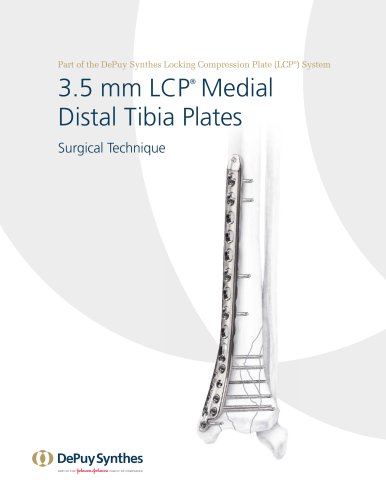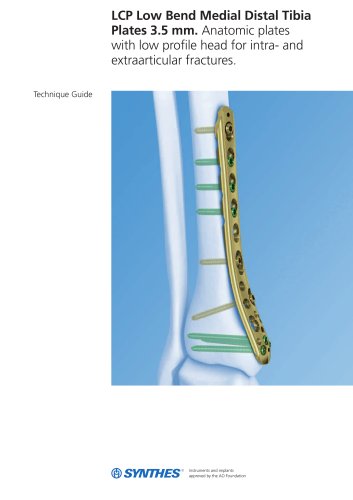
Catalog excerpts

For Capital and Subcapital Fractures of the Ulna 2.0 mm LCP Distal Ulna Plate ® Surgical Technique
Open the catalog to page 1
2.0 mm LCP Distal Ulna Plate Surgical Technique Clinical Examples Approach Reduce Fracture and Position Plate Adjust Length and Complete Fixation Closure Implant Removal Product Information Implants Instruments MR Information The 2.0 mm LCP Distal Ulna Plate System has not been evaluated for safety and compatibility in the MR environment. It has not been tested for heating, migration or image artifact in the MR environment. The safety of the 2.0 mm LCP Distal Ulna Plate System in the MR environment is unknown. Scanning a patient who has this device may result in patient injury. Image...
Open the catalog to page 3
2.0 mm LCP® Distal Ulna Plate. For capital and subcapital fractures of the ulna. The distal ulna is an essential component of the distal radioulnar joint, which helps provide rotation to the forearm. The distal ulnar surface is also an important platform for stability of the carpus and, beyond it, the hand. Unstable fractures of the distal ulna therefore threaten both movement and stability of the wrist. The size and shape of the distal ulna, combined with the overlying mobile soft tissues, make application of standard implants difficult. The 2.0 mm LCP® Distal Ulna Plate is specifically...
Open the catalog to page 4
Narrow plate design, low screw -plate profile, rounded edges and polished surface are designed to minimize irritation of overlying soft tissue Pointed hooks grip the styloid process and provide a reference point for plate application Round locking holes in the head accept 2.0 mm locking screws Combi holes accept either 2.0 mm locking or cortex screws and allow locking or compression throughout the length of the plate shaft Angled locking screws securely hold the ulnar head 2.0 mm LCP® Distal Ulna Plate Surgical Technique DePuy Synthes
Open the catalog to page 5
The 2.0 mm LCP Distal Ulna Plate is indicated for fixation of fractures, osteotomies, nonunions, replantations, and fusions of small bones and small bone fragments, particularly in osteopenic bone. 4 DePuy Synthes 2.0 mm LCP® Distal Ulna Plate Surgical T
Open the catalog to page 6
Clinical Examples Examples include: – Fractures of the ulnar head where the articular surface is either displaced, rotated, or tilted – Comminuted extra-articular fractures of the ulnar neck threatening stable congruency of the distal radioulnar joint Note: Not all fractures of the distal ulna require internal fixation. Many simple ulnar styloid fractures demand nothing more than symptomatic treatment. Displaced articular surface Rotated articular surface Tilted articular surface 2.0 mm LCP® Distal Ulna Plate Surgical Technique DePuy Synt
Open the catalog to page 7
Modular Mini Fragment LCP Instruments and Implants Set Titanium LCP Modular Mini Fragment Instruments and Implants Set 1 Approach The ideal insertion site for this implant is located toward the ulnar styloid and between the flexor carpi ulnaris and extensor carpi ulnaris tendons. Make a longitudinal skin incision over the palpable ulna, taking care to avoid the dorsal sensory branch of the ulnar nerve, which crosses the bone at this level. Once the distal shaft of the ulna is visible, subperiosteal dissection will allow the fracture fragments to be visualized and reduced. Gently retract the...
Open the catalog to page 8
Reduce Fracture and Position Plate 2 Contour plate (optional) Instrument 329.12 Bending Pliers, for 1.5 mm and 2.0 mm plates If necessary, contour the plate using the flat-nosed pliers. Notes – The plate holes have been designed to accept some degree of deformation. The undercut helps to ensure that the threaded holes will not be distorted with typical contouring. Significant distortion of the threaded holes will reduce locking effectiveness. – If possible, the plate should not be cut since the resulting sharp edges can irritate the overlying soft tissues. Precaution: The plate features...
Open the catalog to page 9
Reduce Fracture and Position Plate 3. Reduce fracture and position plate continued In simple fractures of the ulnar neck, apply the plate to the subcutaneous border of the distal ulna, securing points of fixation in both the head and the shaft. Note: It may be necessary to temporarily stabilize the fracture with a transtyloid 1.1 mm guide wire. The wire should be inserted between the distal hooks of the temporarily applied plate. Precaution: The head of the distal ulna is often fragile. Caution should be exercised if using pointed reduction forceps, since the force of this instrument may...
Open the catalog to page 10
4 Fix plate distally Instruments 310.507 mm Drill Bit with Depth Mark, mini quick 1.5 coupling, 96 mm 311.01 Handle, with mini quick coupling 2.0 mm Screwdriver Blade, self-retaining, StarDrive, short 2.0 mm Screwdriver Blade, self-retaining, StarDrive, long 319.006 Depth Gauge, for 2.0 mm and 2.4 mm cortex screws, measures up to 50 mm 323.034 mm Threaded Drill Guide, with depth 1.5 gauge Secure the drill guide in the desired hole. Predrill the hole with the 1.5 mm drill bit through the drill guide, and measure screw length directly from the gauge. Remove the drill bit and drill guide....
Open the catalog to page 11
4. Fix plate distally continued Insert the appropriate length 2.0 mm locking screw. 11 DePuy Synthes 2.0 mm LCP® Distal Ulna Plate Surgical T
Open the catalog to page 12
Adjust Length and Complete Fixation 5 Adjust length and complete fixation Multiple options for screw insertion in the distal portion of the plate allow a wide range of fracture patterns to be securely stabilized. Option 1 In fractures which require length adjustment, place one or two 2.0 mm locking screws in the ulnar head to securely fix the implant distally. Place a 2.0 mm cortex screw in the oblong hole of the shaft, and obtain the correct length of reduction. Use a combination of cortex and locking screws in the surrounding holes to stabilize the fracture securely, as dictated by bone...
Open the catalog to page 13
Adjust Length and Complete Fixation 5. Adjust length and complete fixation continued Option 3 Instrument 314.67.96** or 314.667* 1.5 mm/2.0 mm Cruciform Screwdriver Blade, with holding sleeve 1.5 mm Cruciform Screwdriver Blade, with spring holding sleeve, short In fractures where it is necessary to stabilize the tip of the ulnar styloid process, the distal plate hole is left empty. Remove the 1.1 mm wire, which was used for preliminary fixation (see note, Step 3). Overdrill the near fragment with a 1.5 mm drill bit. Insert a 1.5 mm cortex screw in lag mode between the arms of the distal...
Open the catalog to page 14All Depuy Synthes catalogs and technical brochures
-
Building on Success
16 Pages
-
RADIUS OF CURVATURE
3 Pages
-
Introducing The Variable Angle
12 Pages
-
HEALIX Anchor™ 3.4 mm
2 Pages
-
Small Battery Drive II
4 Pages
-
HEALIX ADVANCE
4 Pages
-
3.5 mm LCP™ Medial
15 Pages
-
Titanium Sternal Fixation System
34 Pages
-
MatrixRIB®FixationSystem
86 Pages
Archived catalogs
-
2.4 mm VA LCP™
4 Pages
-
Mandible Trauma Solutions
2 Pages
-
Power line II
4 Pages
-
Concorde
28 Pages
-
LCP Intercarpal
31 Pages
-
LCS® COMPLETE™
2 Pages
-
Synthes TPLO.
8 Pages
-
SynFix-LR System
56 Pages
-
ATB Anterior Tension Band Plate
32 Pages
-
CONDUIT™
15 Pages
-
Brochure_FINAL
2 Pages
-
DePuy Synthes
81 Pages
-
Anspach
3 Pages
-
Orthopedic Foot Instruments
32 Pages
-
PINNACLE® Hip Solutions
12 Pages
-
Corail
24 Pages
-
S-ROM® NOILES™
68 Pages
-
TRI-LOCK® Product Rationale
12 Pages
-
Reclaim Surgical Technique
44 Pages
-
Speed
2 Pages
-
attune
80 Pages
-
HAMMERLOCK® 2
2 Pages
-
DePuy Glenoid Solutions
2 Pages
-
Trauma Solutions. Elbow
4 Pages
-
Polar
4 Pages
-
Alveolar Distractor.
4 Pages
-
Piezoelectric System
4 Pages
-
Air Power Line II
6 Pages
-
LCP Clavicle Hook Plate
4 Pages
-
TruMatch Pin Guides
16 Pages
-
P F N A
8 Pages
-
SKILL, DEDICATION,
16 Pages
-
Orthopaedics. Overview
20 Pages
-
DURALOC
16 Pages
-
Marathon Cemented Cup
20 Pages
-
REEF Surgical Technique
16 Pages
-
MatrixNEURO
8 Pages
-
Anspach XMax
4 Pages
-
Anspach eMax 2 Plus
4 Pages
-
Small Electric Drive
4 Pages
-
Air Pen Drive
4 Pages
-
Colibri II
4 Pages
-
Spine
25 Pages
-
Expert Hindfoot Arthrodesis Nail
48 Pages
-
LCP Distal Fibula Plates
32 Pages
-
TomoFix
60 Pages
-
Expert Tibial Nail PROtect
16 Pages
-
Expert Tibia Nail
84 Pages
-
Sacral Bars
16 Pages
-
Pelvic C-Clamp
20 Pages
-
Low Profile Pelvic System
16 Pages
-
Proximal Femoral (Hook) Plate
24 Pages
-
LCP
24 Pages
-
PFNA
112 Pages
-
HCS 1.5, 2.4, 3.0
36 Pages
-
LCP Wrist Fusion
32 Pages
-
LCP Compact Hand
28 Pages
-
VA-LCP Elbow
48 Pages
-
Distal Radius
44 Pages
-
Olecranon
30 Pages
-
LCP Hook Plate
28 Pages
-
DHP & Olecranon
4 Pages
-
LCP S-A
4 Pages
-
Epoca
4 Pages
-
Philos
32 Pages
-
MultiLoc
68 Pages









































































































